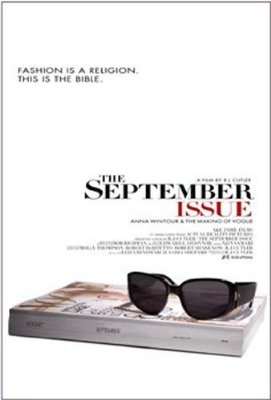Canadian Magazine Industry News
23 October 2009, TORONTO
Guest review: Stacey May Fowles on The September Issue
Editors note: Chroncling the production and release of the September 2007 issue of Vogue, The September Issue has been a hot topic in magazine and fashion circles for months. Blogger Stacey May Fowles recently saw the film and sent us her critique.
Magazine professionals often use words like “passion” to describe why they got involved in the industry, but an astute viewer of The September Issue could easily walk out and wonder why on earth we even bother to do this thing called magazines. A majority of the early Canadian reviews of The September Issue focus on how it is a film about the shallow and cutthroat world of fashion. Anna Wintour, editor of Vogue, is depicted as a icy tyrant who, although undeniably
powerful, is deeply unhappy, incapable of sharing affection with her colleagues, employees and designers, all of whom seem to deeply fear her. Grace Coddington, Vogue’s creative director, is depicted as a disregarded and disrespected genius, her ridiculously beautiful photos disposed of on Anna’s erratic whims (“not enough texture,” “too pretty,” “too toothy”). Quiet moments with Coddington reveal endless, heartbreaking disappointment, and a sense that she has come to accept that this is the way it will always be. The remaining cast of characters seem to run around frantically in an endless fit of absurdity. (The film is worth a watch for US Vogue's Editor-at-Large André Leon Talley's ridiculous tennis attire alone).
When the movie is not a comical mockery, it gives off a sense of collective misery, and calls in to question why anyone would even want to be part of an industry so thankless. You know, the thankless “fashion industry.”
The film does indeed teach that fashion is a fickle friend, but as an audience member who was more riveted by the vague mention of a Vogue cover meeting I would argue that the ruthless environment in which the documentary’s key players act out their daily dramas is equally (if not more) a result of their print media titles.
Wintour’s demeanor throughout the film may seem cold, inhumane, and dismissive, but to many a mag folk it also seems completely necessary. When you consider she’s arguably the most powerful woman in two very erratic industries, it is hard not to sympathize with her stoic nature. Of course it would be nice if Wintour was in a position to be warm to her colleagues and underlings, but that’s just not the way magazines work. The ship would sink without her intimidation, however dramatic it appears. It’s clear that the moral of the story is that both spheres are not for the tenderhearted—the daily frustrations felt by Vogue’s editors, designers, stylists, and the like are evident in every scene in the film. There’s also a sense of post-partum in the final scenes as the 820 page book gets shipped and these characters we’ve invested in move on to the new conflict called the October Issue.
On the surface the Vogue offices are a far cry from any Canadian magazine I’ve ever witnessed, and the Vogue advertising team could fill a lecture hall, but one thing is clear ⎯ the frustrations, disappointment, and anger I saw in the film was all too familiar. The reality is that with late nights and intense deadlines, the people who work (perhaps too) closely together at magazines become a kind of surrogate family, and develop a kind of intense affection for each other that precludes niceties. The relationship between Wintour and Coddington is typical of mag types who have shared a professional space for more than two decades (and with the long hours, in mag years that’s about fifty). Both are uncompromising, lazy with pleasantries, and in some ways, tired of it all. Coddington spends most of the film feeling under-appreciated, only for us to learn in the final scenes that Wintour has a deep admiration for her we would of previously thought she was incapable of. For these reasons, The September Issue is a useful film for magazine professionals to use to dissect the universal (and occasionally dysfunctional) family dynamics in magazine office environments.
When you collectively create a thing based on passion, you’re bound to get angry, and as Wintour herself instructs “when you get angry enough," [that’s when you] should leave."
Stacey May is the circulation and marketing director at The Walrus and volunteer publisher of Shameless, a feminist magazine for teenage girls. She has assisted in circulation and business development projects for Descant, Magazines Canada and Hive Magazine. She also writes the blog Circ Without Shame on Masthead.
Magazine professionals often use words like “passion” to describe why they got involved in the industry, but an astute viewer of The September Issue could easily walk out and wonder why on earth we even bother to do this thing called magazines. A majority of the early Canadian reviews of The September Issue focus on how it is a film about the shallow and cutthroat world of fashion. Anna Wintour, editor of Vogue, is depicted as a icy tyrant who, although undeniably
 |
|
The September Issue
|
When the movie is not a comical mockery, it gives off a sense of collective misery, and calls in to question why anyone would even want to be part of an industry so thankless. You know, the thankless “fashion industry.”
The film does indeed teach that fashion is a fickle friend, but as an audience member who was more riveted by the vague mention of a Vogue cover meeting I would argue that the ruthless environment in which the documentary’s key players act out their daily dramas is equally (if not more) a result of their print media titles.
Wintour’s demeanor throughout the film may seem cold, inhumane, and dismissive, but to many a mag folk it also seems completely necessary. When you consider she’s arguably the most powerful woman in two very erratic industries, it is hard not to sympathize with her stoic nature. Of course it would be nice if Wintour was in a position to be warm to her colleagues and underlings, but that’s just not the way magazines work. The ship would sink without her intimidation, however dramatic it appears. It’s clear that the moral of the story is that both spheres are not for the tenderhearted—the daily frustrations felt by Vogue’s editors, designers, stylists, and the like are evident in every scene in the film. There’s also a sense of post-partum in the final scenes as the 820 page book gets shipped and these characters we’ve invested in move on to the new conflict called the October Issue.
On the surface the Vogue offices are a far cry from any Canadian magazine I’ve ever witnessed, and the Vogue advertising team could fill a lecture hall, but one thing is clear ⎯ the frustrations, disappointment, and anger I saw in the film was all too familiar. The reality is that with late nights and intense deadlines, the people who work (perhaps too) closely together at magazines become a kind of surrogate family, and develop a kind of intense affection for each other that precludes niceties. The relationship between Wintour and Coddington is typical of mag types who have shared a professional space for more than two decades (and with the long hours, in mag years that’s about fifty). Both are uncompromising, lazy with pleasantries, and in some ways, tired of it all. Coddington spends most of the film feeling under-appreciated, only for us to learn in the final scenes that Wintour has a deep admiration for her we would of previously thought she was incapable of. For these reasons, The September Issue is a useful film for magazine professionals to use to dissect the universal (and occasionally dysfunctional) family dynamics in magazine office environments.
When you collectively create a thing based on passion, you’re bound to get angry, and as Wintour herself instructs “when you get angry enough," [that’s when you] should leave."
Stacey May is the circulation and marketing director at The Walrus and volunteer publisher of Shameless, a feminist magazine for teenage girls. She has assisted in circulation and business development projects for Descant, Magazines Canada and Hive Magazine. She also writes the blog Circ Without Shame on Masthead.
Comments (5) Post a Comment
Most Recent News Comment
 |
|
| Jaded says: | |
Wow, Torstar really seems to be on a mission to bankrupt one magazine after another.... |
|
Most Recent Blog Comment
 |
|
| Lorene Shyba says: | |
Full of terrific information, Thanks!... |
|
Most Read Stories
Special Reports




